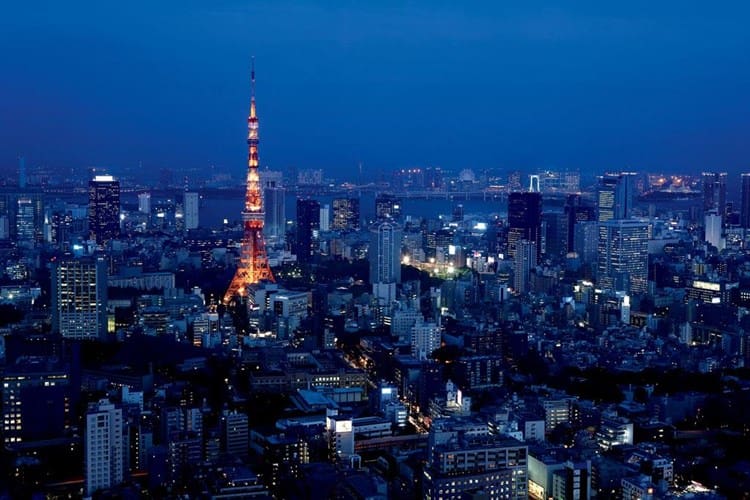
By: Lisa Pitzer
This summer, I enjoyed an incredible experience in Tokyo! I was invited to participate in a trip sponsored by ANA, Shangri-La Hotels, and the Metropolitan Washington Airport Authority. It was organized so that a group of travel professionals could experience Tokyo firsthand and share what we learned with our clients. Let me tell you what I did there and I’m sure you’ll want to visit, too.
The Business of Getting There
Our trip began at Washington Dulles Airport. A representative from the Metropolitan Washington Airport Authority was on hand to greet us, along with a representative from ANA, and they welcomed our group in style. They led us to the Lufthansa Business Lounge, which ANA also uses. We thoroughly enjoyed the food, beverages, and very relaxed setting as we got acquainted with our fellow travelers before the 12-hour flight to Narita, Tokyo’s bustling international airport.
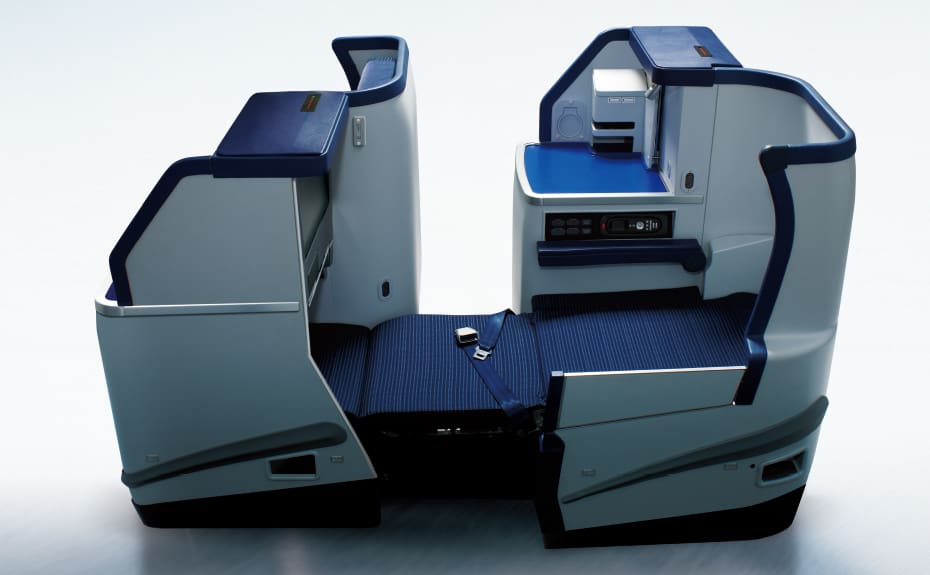
As we boarded our flight and were ushered to our Business Class seats, I was amazed at the very private, yet spacious “pod” with every bell and whistle you can imagine. It took me a full five minutes to explore every function, pushing buttons at random like a five-year-old! The seats are staggered so that you are not directly next to any other traveler, making it very private and easy to relax. I especially loved the leg room because, like many others, I often struggle with swollen feet when flying. Even in an upright position, I had the option to put my feet up on a sort of ottoman built into the entertainment console in front of me.
The dining options were varied, and even though I forgot to inform them in advance that I am a vegetarian, they were able to accommodate me with a delicious vegetarian meal. I was also introduced to Shochu, a Japanese liquor. I liked it so much that it’s now in my arsenal of go-to cocktails in my home bar. Of course, after a great meal and a cocktail, it was time to hit the switch that magically turned my very comfortable seat into a lie-flat bed. I have never been one to sleep on a plane, but I will admit that I did actually doze off several times while I perused the menu of movies, TV shows, and music. The 12 hours seemed to float by, and although I really never slept, I arrived in Tokyo rested, relaxed, and happy.
Narita Airport
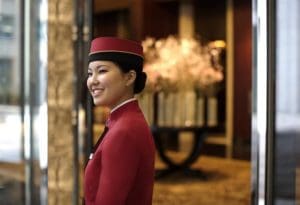
Narita Airport is fairly easy to navigate and our journey through customs and immigration was swift and uneventful. We took a tour of the airport and visited the ANA Arrivals lounge for refreshments before boarding the Narita Express train for the hour-long trip to the city.
When we arrived at Tokyo Station it was nearing the afternoon rush hour and we got a firsthand look at the busiest train station in the city. Luckily, the Shangri-La Hotel provides an escort for all of their guests, meeting you the minute you get off the train, whisking your baggage onto a cart and maneuvering the labyrinth of the train station, which I’m sure all of their weary jet-lagged guests appreciate. The Shangri-La is located adjacent to Tokyo Station, so it was only a five-minute walk to the hotel.
Shangri-La Tokyo
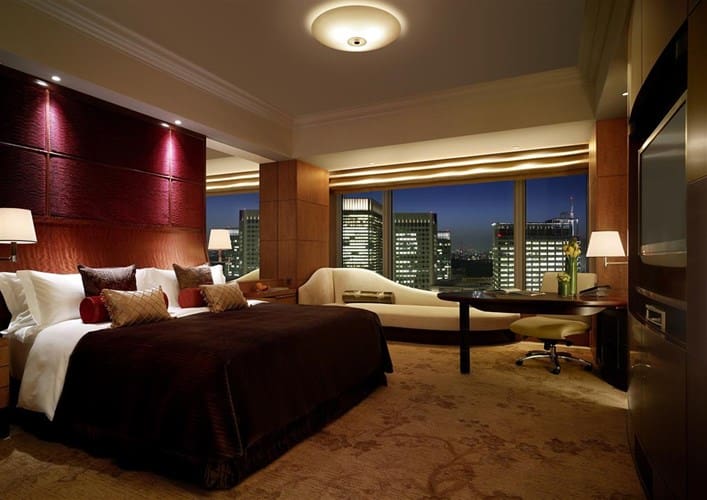
Upon arrival at the hotel, we were whisked off to a private room off of the lobby and given champagne to sip while we got acquainted with our hosts at the Shangri-La. Once in my room, I hesitated, thinking there was a mistake, and that they gave me a suite intended for someone much more important than me. I later realized this is a standard deluxe room at the Shangri-La, although it was quite spectacular.
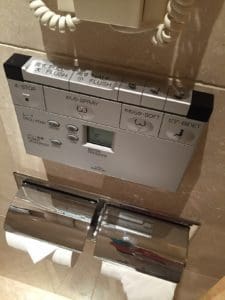
The bathroom was larger than my living room at home and included a huge soaking tub and rain shower encased in a glass room, double sinks, and a toilet room. I won’t go into details, but the toilet actually had more buttons than my airplane seat, and again I tested them all.
A king-sized bed piled high with luxurious linens beckoned to me, as I hadn’t had any real sleep since leaving Virginia almost 24 hours before. I resisted the urge to dive under the covers and instead made some tea and relaxed on my lounging couch as I looked out the huge window at the city lights of Tokyo.
Dinner was at the Gonpachi Nishiazabu Resturant, which was made famous when the “Bride vs. the Crazy 88’s” fight scene from Kill Bill Vol. 1 was filmed here. We were seated upstairs in a cozy nook with a low table and a view of the floating lanterns and buzzing restaurant below. Although this is known as a tourist spot, and there did seem to be a large number of non-Japanese folks, the food and drinks were very good. Our hosts kept the small plates coming and the sake flowing.
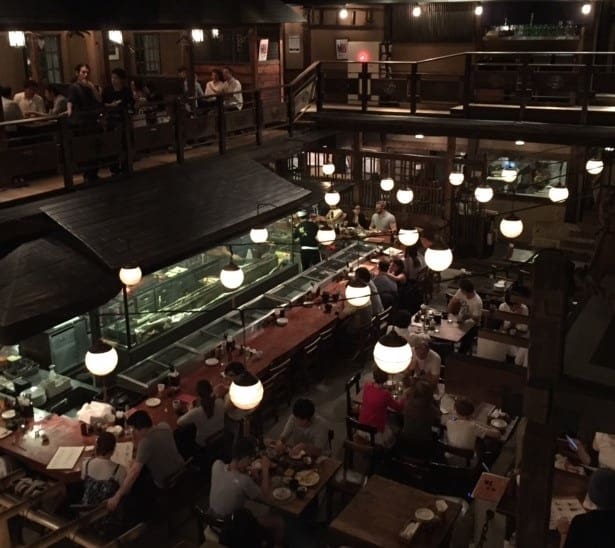
Finally, back in my room, I dove into bed, leaving the window drapes open so that I could look out at the city lights of Tokyo before I dozed off into an exhausted sleep. What I didn’t realize is that in July, the sun rises at 4:30 AM in Tokyo and my open drapes made this very clear to me!
Fish Market Frenzy
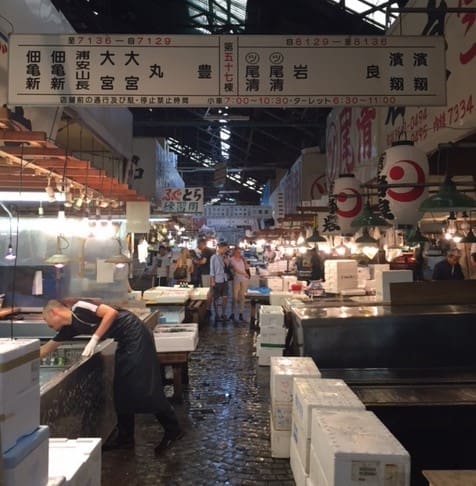
We started our day by meeting our Japanese guide for the week, Takoko, who works with a creative tour operator, the Art of Travel. Our first stop was Tsukiji, the largest fish market in the world. Being a vegetarian, I was not thrilled at the concept of walking through this market selling fish, displaying fish, and sometimes dissecting fish. I popped mints and breathed through my mouth, but eventually found myself caught up in the energy of the place. Vendors whizzed by on scooters and small forklifts, doing their job and ignoring the American tourists who were in their way.
Takoko told us that the real estate where the market currently sits is some of the most valuable real estate in the city, and the land will be repurposed for the 2020 Olympics. The fish market will be moved out of central Tokyo across Tokyo Bay. (Update: as of August 31, the move has been placed on indefinite hold.)
A Shrine of Love
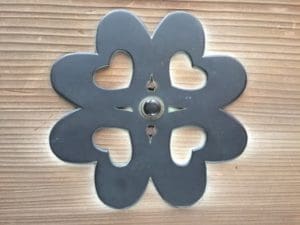
Next, we made our way to the Meiji Shrine, composed of 175 acres of gardens, trees and a beautiful shrine in the Shibuya area of Tokyo. After the fish market, I greatly appreciated the fresh air and sweeping gardens. The entrance is marked by a 40-foot gate made of 1,500-year-old cypress, and large displays of colorful sake barrels given as gifts to the shrine from cities all over Japan.
I watched as several locals approached the shrine, tossed coins into the offering box, bowed twice, clapped twice, and bowed once more. The architecture was fascinating and I noticed there was a heart design cleverly integrated into the hinges and hardware of all the doors and gates.
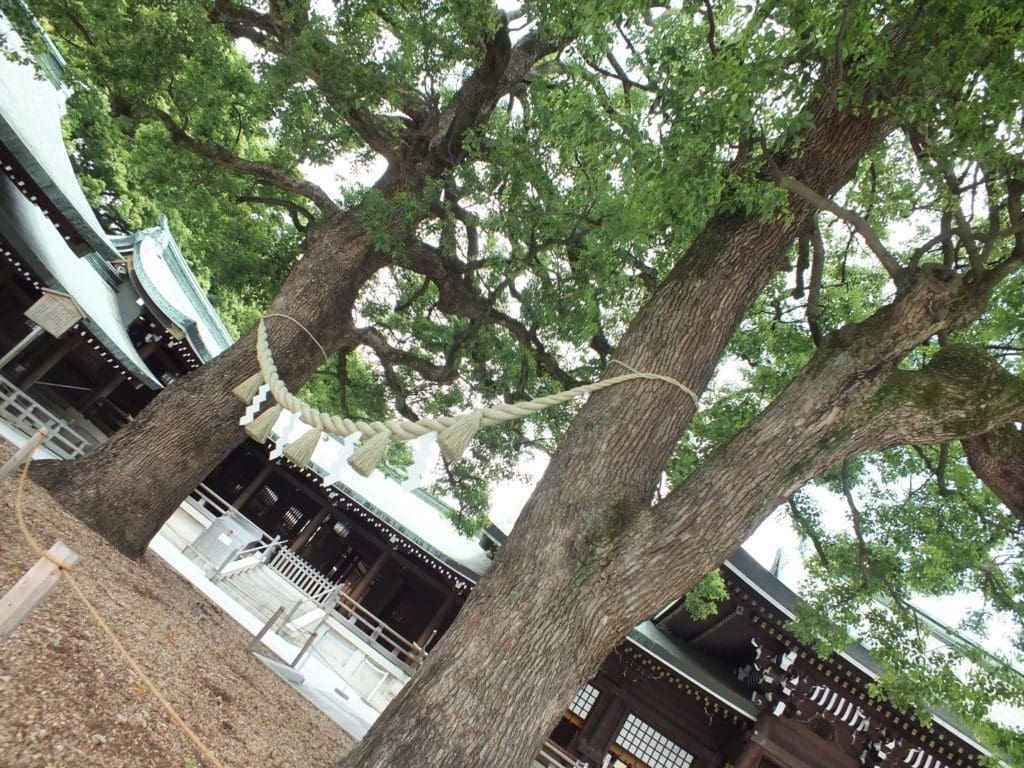
Two large trees connected by an elaborate rope represent the Emperor and Empress Meiji. This is where couples offer prayers for a good marriage – so that explains the heart motif around the shrine. I was struck by the romance of the place, and it’s no wonder that this is a popular spot for weddings.
Haneda Airport
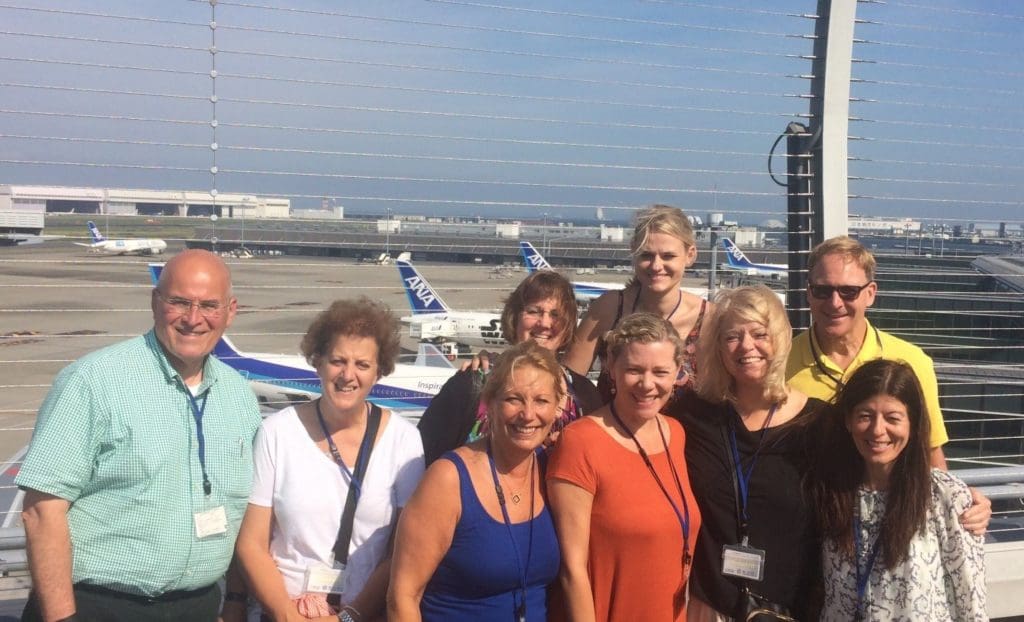
Off to lunch in the Kagurazaka neighborhood, where Takoko told us this is one of the few remaining neighborhoods where it is not unusual to spot a geisha strolling down the street. Alas, we saw no geisha but enjoyed wandering down the cobblestone paths and peeking into small shops.
In the afternoon, we were treated to a tour of Haneda airport, which is the much smaller, much more manageable airport that serves Tokyo. Most domestic flights within Japan use this airport, but it also offers nonstop service to 25 cities in 17 countries. We especially enjoyed the outdoor viewing deck where you can watch the jets take off and land.
Michelin-Starred Dining
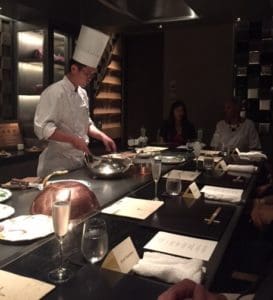
For dinner, we were hosted by the incredibly beautiful Ritz-Carlton. The Ritz occupies the top nine floors, of a 53-story high-rise in the hip Roppongi district. The views from the bar, restaurants, rooms and spa/fitness center are breathtaking. I had a hard time focusing on conversations because I couldn’t stop looking out at the lights of Tokyo, including the famous Tokyo Tower. I’m told that on a clear day you can see Mt. Fuji.
Our meal was served at a private chef’s table in the Hinokizaka Restaurant, the only Japanese hotel restaurant to have earned a Michelin Star. We watched the chefs prepare our meals right in front of us and the courses just kept coming, along with paired sake. This was easily one of the best meals of my life.
Architectural Disappointment
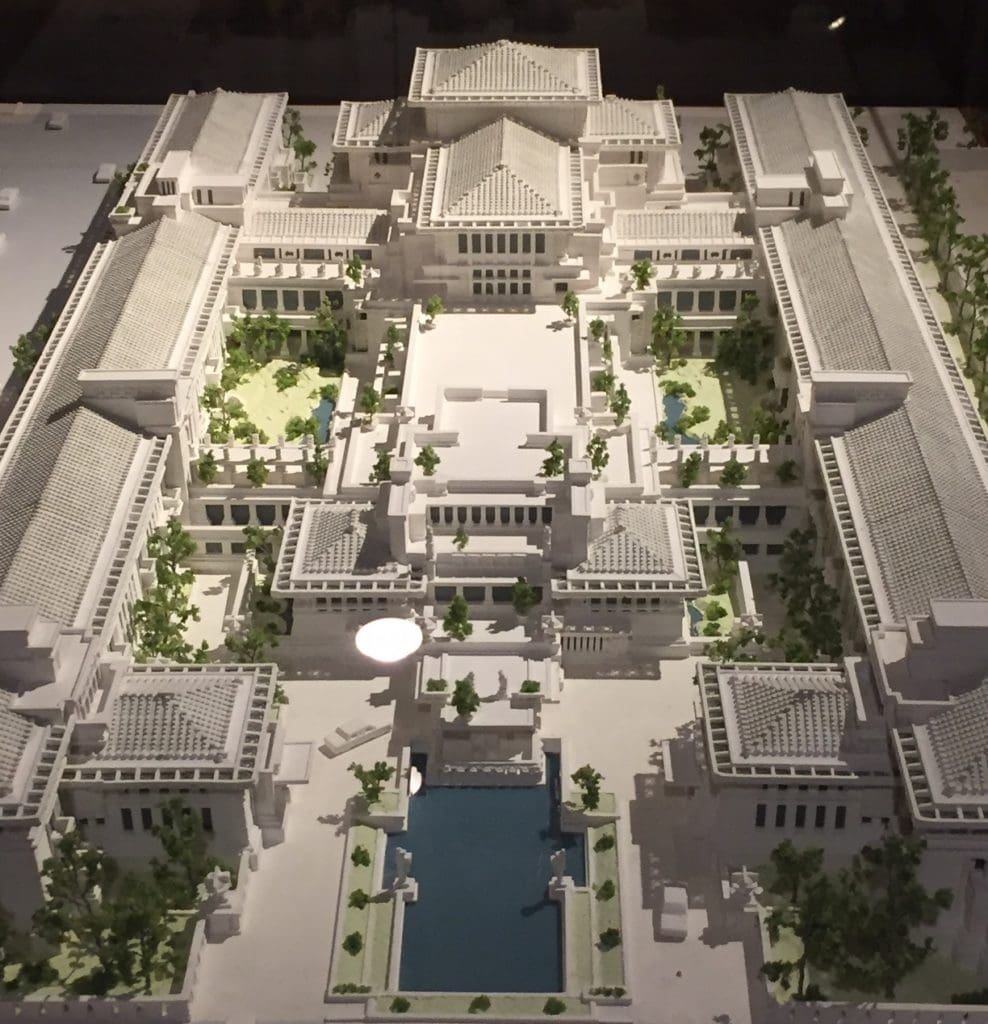
Back at the hotel, once again I couldn’t bear to close my drapes on the city lights, so I was up with the sun the next morning. Since I had some time to kill before breakfast, I set off on an adventure to find the Imperial Hotel, designed by one of my favorite historical figures Frank Lloyd Wright. What I didn’t realize until I arrived at the address is that the original Imperial Hotel was replaced by an unattractive high rise, still called the Imperial Hotel. This was not at all what I was looking for, but I went inside anyway.
Since I was the only person in the lobby at 5:00 a.m., the bellman seemed interested in helping me. When I mentioned Frank Lloyd Wright, he brightened and pointed me to the second-floor lobby where I found a scale model of the original hotel.
It was there that I learned the hotel was damaged in an earthquake in 1923 and again during WWII. Time and upkeep eventually took their toll and the hotel was razed in 1967, the year I was born. I walked the twelve or so blocks back to my hotel, marveling at how empty the streets were at 6:00 a.m., and how incredibly hot and humid a July morning in Tokyo can be.
A Temple, Shopping, and a Museum
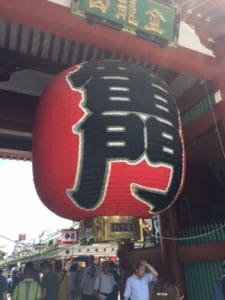
Our group headed off to one of the most popular tourist destinations in the city, the Sensoji Temple, Tokyo’s oldest temple. We walked the shopping area leading up to the temple and paused for pictures in front of the main gate, Kaminarimon, or Thunder Gate, which is known for the huge brightly painted lantern that marks the entrance. The temple was destroyed in WWII but later rebuilt as a symbol of peace and resurrection.
Our next stop was a shopping area called Kappabashi, an area devoted solely to shops selling kitchen and restaurant supplies. Each shop specializes in a particular item. For example, one store only sells chopsticks, another only plates and bowls, another sake sets, and so on. I discovered a shop selling bowls, plates, and platters made of wood, and decided they would be good, lightweight souvenirs that would actually fit in my suitcase.
Because it was a very hot day, we headed off to the air conditioning of the Tokyo Edo Museum. This cleverly designed museum walks you through 400 years of the city’s history, and you can experience the history, art, culture, disasters, wars, and governments that make up Tokyo’s history.
A Traditional Japanese Tea Ceremony
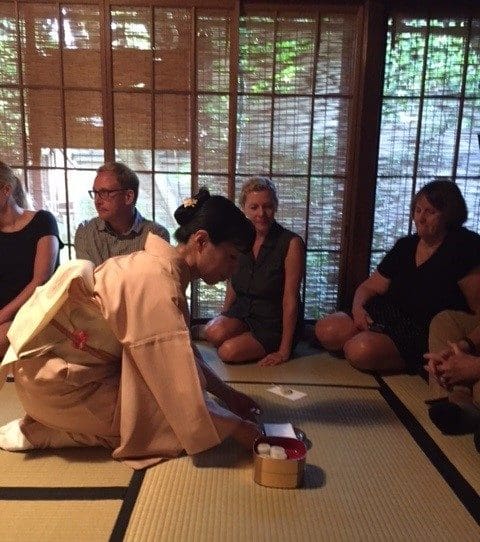
One of the most interesting and charming activities that we experienced was a traditional Japanese Tea Ceremony. Takoko arranged a special treat for us, as this particular tea house does not normally open up to tourists.
Our two hosts were extremely beautiful and charming, wearing impeccable kimonos. We were led into a waiting area where we stored our bags, removed our shoes, and donned wooden sandals, or Geta. As we were led into the tea house, the door was very small, so we had to duck inside. Our American bodies struggled to duplicate the sitting posture of our Japanese friends and we were informed that it is impolite to show the bottoms of our feet. We adjusted accordingly, painfully.
We watched as our host prepared the utensils, every movement practiced and precise. We were each given a small sweet bun made with sweet black bean paste. The host then prepared the thick tea by whisking hot water with green macha powder. She bowed to each guest in turn, placing the small bowl of tea in front of them. Each guest bowed back and rotated the bowl before drinking from it. This process repeated until all guests sipped the tea. Once again, the utensils were precisely cleaned and put away. It was all very quiet, elegant and respectful, and I left with a sense of peace. As we drove away, I looked out of the rear window of the van and saw our two hosts bowing to each other.
Furin Painting
We ended the afternoon with a creative activity, furin painting. Furin are Japanese glass wind chimes, and we were given the opportunity to paint our own. The furin is a clear glass globe with the design painted on the inside of the globe. This was an interesting challenge, but the instructor and his wife demonstrated some tips and suggested designs, then turned it over to us to get creative. We all left with a wonderful memory and a fabulous souvenir.
Happi Karaoke
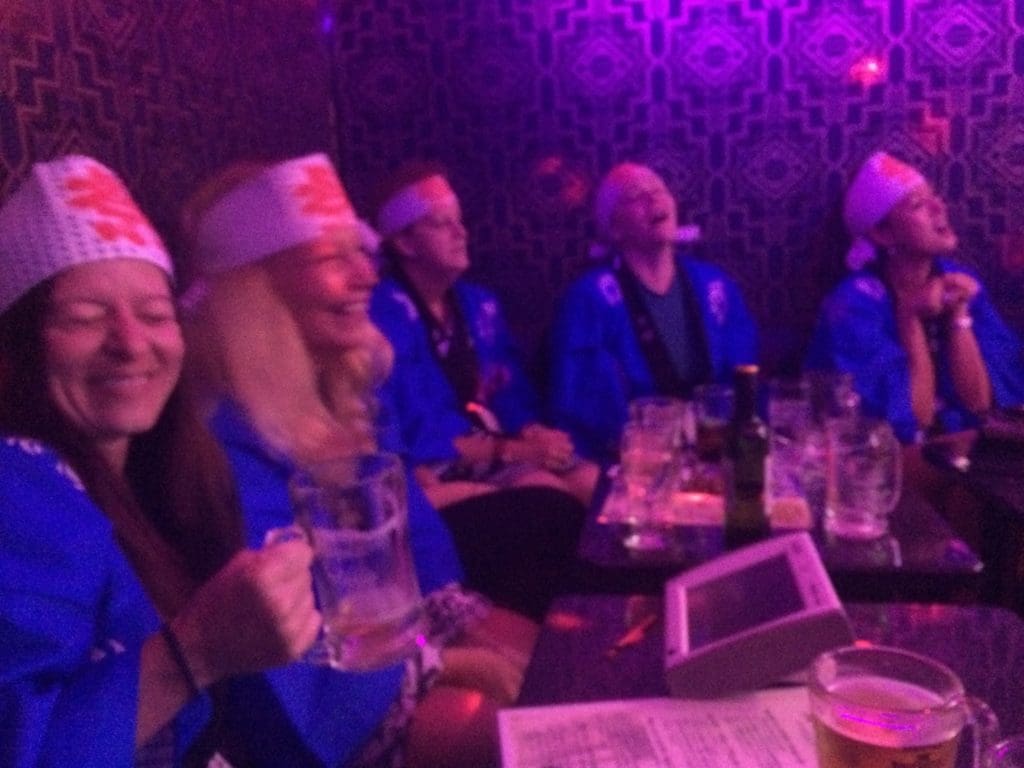
Our final dinner was yet another incredible meal at the Shangri-La, and a wonderful opportunity to thank each of our hosts for such an incredible experience. As we parted ways after our meal, we were told that there was a special surprise in each of our rooms. I rushed up to my room to find a beautifully wrapped package with a note tucked inside. The gift was a traditional cotton Japanese robe called a Happi, worn during festivals and special events. My name was written in Japanese on the lapels, and the note said to don my Happi and meet back in the lobby for a special event.
Our group reconvened in the lobby, all wearing identical Happis, and we made our way en masse a few blocks down the street to our destination, chattering away in our matching outfits. A teenager pointed and sarcastically said in English, “Look, Japanese people!” Teenagers are the same all over the world, apparently.
As we arrived at our destination, we realized we were in for a real treat – Karaoke! Our group crammed into a private Karaoke room, and our Japanese hosts kicked off the night. We took turns picking songs and singing at the top of our lungs until our voices gave out. It was an incredible way to end our trip, laughing and having a fabulous time with our colleagues, hosts, and new friends. There may be videos, but I will deny that it is me singing “Take Me Home, Country Roads.”
Heading Home
The next day we went back to Narita airport for our journey home – happy, tired, and a little sad that we have to leave this incredible group of people that we’ve met, and this very civil, welcoming country. Japan is a place that I will always long to return to, and trust me, I will be back. And I will sing karaoke.
Lisa Pitzer is the Director of Business Travel Services at Covington Travel and has over 25 years experience in the travel industry.






Leave a Reply